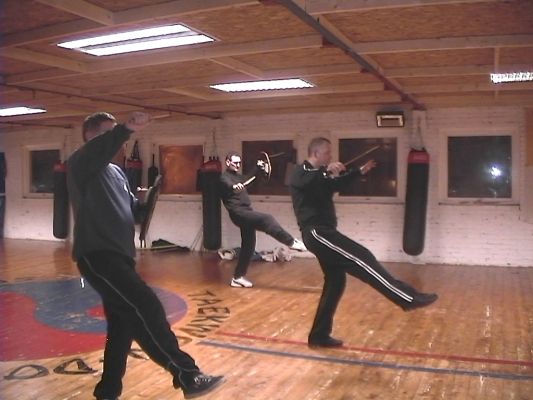From WIKIPEDIA:
Dirk is a Scots word for a long dagger; sometimes a cut-down sword blade mounted on a dagger hilt, rather than a knife blade. The word dirk could have possibly derived from the Gaelic word sgian dearg (red knife). It may also have been a corruption of the Low German words Dulk or Dolk. The shift from dearg to dirk is very minimal.
In Bronze Age and Iron Age Scotland and Ireland, the dirk was actually considered to be a sword. Its blade length and style varied, but it is generally 8-14 inches.
Dirks were made with either double-edged or single-edged blades, and there was no standard blade configuration. Reference books covering naval dirks invariably show the popularity of both blade types. As a consequence, historically there were about as many naval dirks mounting single-edged blades as those with double-edged blades. Some dirks have single-edged blades that also have a false edge near the tip, a feature that could be useful in a backcut.
In medieval Scotland, the dirk was a backup to the broadsword, and was wielded by the left hand while the scabbard was carried on the arm. Dirks were used to swear an oath upon in Celtic cultures. After the Battle of Culloden, the British government troops were aware that the Highlanders normally swore on their dirks, so, to prevent future uprisings or rebellions against the throne, they made them swear on oath never to "possess any gun, sword, or pistol, or to use tartan: "... and if I do so may I be cursed in my undertakings, family and property, may I be killed in battle as a coward, and lie without burial in a strange land, far from the graves of my forefathers and kindred; may all this come across me if I break my oath." Nearly every Scottish male at the time of the oath had a dirk. This was because most Scots were too poor to buy a sword. The dirk was small and was carried everywhere the owner went. The dirk was worn in plain view suspended from a belt at the waist.
Another shorter dagger tucked into a coat sleeve or stocking as part of Highland dress is known as a Sgian Dubh, derived from the arm pit dagger or sgian achlias. To this day, a real or false dirk is sometimes worn as a part of traditional Scottish costume.
Other meanings of 'dirk' as a weapon are
Dirk is a Scots word for a long dagger; sometimes a cut-down sword blade mounted on a dagger hilt, rather than a knife blade. The word dirk could have possibly derived from the Gaelic word sgian dearg (red knife). It may also have been a corruption of the Low German words Dulk or Dolk. The shift from dearg to dirk is very minimal.
In Bronze Age and Iron Age Scotland and Ireland, the dirk was actually considered to be a sword. Its blade length and style varied, but it is generally 8-14 inches.
Dirks were made with either double-edged or single-edged blades, and there was no standard blade configuration. Reference books covering naval dirks invariably show the popularity of both blade types. As a consequence, historically there were about as many naval dirks mounting single-edged blades as those with double-edged blades. Some dirks have single-edged blades that also have a false edge near the tip, a feature that could be useful in a backcut.
In medieval Scotland, the dirk was a backup to the broadsword, and was wielded by the left hand while the scabbard was carried on the arm. Dirks were used to swear an oath upon in Celtic cultures. After the Battle of Culloden, the British government troops were aware that the Highlanders normally swore on their dirks, so, to prevent future uprisings or rebellions against the throne, they made them swear on oath never to "possess any gun, sword, or pistol, or to use tartan: "... and if I do so may I be cursed in my undertakings, family and property, may I be killed in battle as a coward, and lie without burial in a strange land, far from the graves of my forefathers and kindred; may all this come across me if I break my oath." Nearly every Scottish male at the time of the oath had a dirk. This was because most Scots were too poor to buy a sword. The dirk was small and was carried everywhere the owner went. The dirk was worn in plain view suspended from a belt at the waist.
Another shorter dagger tucked into a coat sleeve or stocking as part of Highland dress is known as a Sgian Dubh, derived from the arm pit dagger or sgian achlias. To this day, a real or false dirk is sometimes worn as a part of traditional Scottish costume.
Other meanings of 'dirk' as a weapon are
- a side arm worn by officers, midshipmen, and cadets of the world's navies.
- a short-bladed weapon used in the Middle Bronze Age (c. 1500-1100 BC).
- a thrown weapon, as opposed to a melee weapon.
- a short dagger used by Pirates.
- a small, straight-bladed dagger carried for personal protection.


